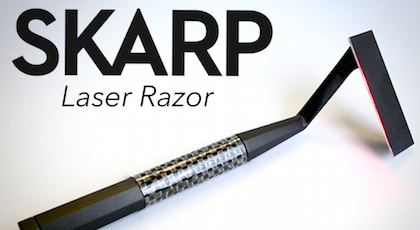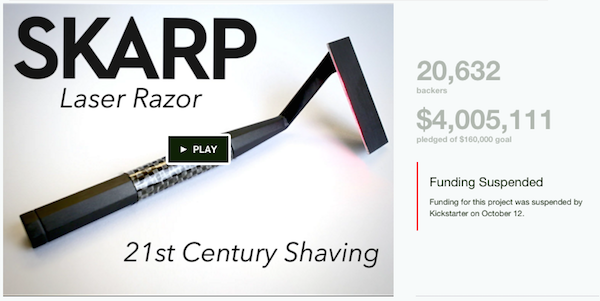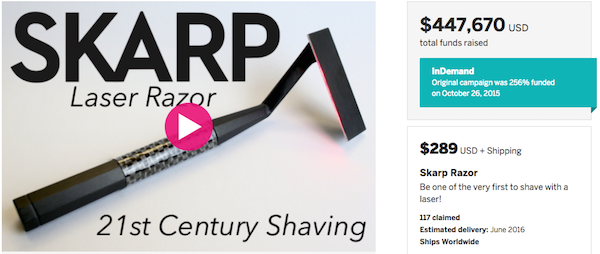Skarp Technologies launched a Kickstarter campaign for the first laser-powered razor on September 21 2015. The project raised over $4,000,000 from 20K+ backers before it was unexpectedly suspended on Oct 12.
Seemingly without hesitation, Skarp Technologies quickly relaunched a 13 day Indiegogo campaign that raised over $252,000 from 1.6K+ backers in two days. It’s safe to say the crowd wants this thing made. The company has had no problem reaching a $160K funding goal on Kickstarter OR Indiegogo.
Having their Kickstarter campaign suspended was a huge hurdle, but the creators of this new invention are determined to realize their dream of an even closer shave. They have surpassed the funding goal for their Indiegogo campaign and this product is now (hopefully) set to ship in March 2016 – so what can we learn from Skarp Technologies?
Here are 5 lessons to learn from this project’s viral crowdfunding success, from coming up with a revolutionary idea to why they got suspended on Kickstarter:
1. Offer simple, in-demand rewards
Skarp Technologies’ Kickstarter campaign had eight straightforward reward tiers. Seven of the eight tiers included at least one of the new and exciting Skarp Laser Razors (except for the $5 pledge tier). All of the limited early bird rewards were sold out on Kickstarter, which were available to thousands of backers at the start of the campaign.
The trouble with rewards is figuring out what your customers want and the best way to offer it to them. You want options, but not so many that it becomes confusing for people to decide on their pledge. Ideally, they should be able to read through your rewards quickly and get a “This is the right one for me” type feeling.
2. Get and display media coverage
The Skarp Laser Razor has been creating quite a buzz. Their page proudly displays that the campaign has been featured on ABC News, NBC News, CBS, TechCrunch, BuzzFeed, CNET, Business Insider, Mashable, Maxim AND more.
The popularity of this project is likely one of the reasons that it eventually raised a flag for Kickstarter – it has also contributed to why people are so eager to back this project. Yes, there is a chance that the creators could run into some problems that make manufacturing this thing nearly impossible, but they also might pull it off.
In this article, we’re not highlighting the creator’s fulfillment strategy. We’re focusing on the marketing of the product. We leave it up to great entrepreneurs like you to make good on your promises, otherwise, you’ll have a slew of unhappy customers and an unsustainable business.
3. Introduce something new that solves a problem
Just like the creators mention in their pitch, razor design has stayed pretty much the same for about 5,000 years. Now Skarp Technologies has come along with a solution that promises: no scratches, razor burn, infection, itch or accidental cutting (just to name a few benefits).
These are problems that both men and women experience, so it’s not surprising how many people are jumping through hoops to fund this new technology! Products that serve either genders or more than one age group can be easier to sell than products that appeal only to a small group or subgroup.
4. Know the platform rules
It’s true that some crowdfunding platforms’ rules are vague and sometime when platforms suspend projects the decision seems a little arbitrary. Most of the time these rules are there to protect backers though, from things like fraud to sheer weirdness (like this project).
Skarp Technologies’ got suspended because Kickstarter wasn’t satisfied with their prototype. Although the Skarp Laser Razor has basic functionality, from the video it was clear that the prototype that they have is still far from what they are promising for the finished product.
5. Make sure backers get all of the important info about your project
Skarp Technologies’ Kickstarter page is practically flawless in terms of the important elements that should be included for a successful crowdfunding campaign. Their page includes a good description of the design, an explanation as to why backers should support the project, info about the founders (and in this case even an advisory group), timelines, a Q&A (on Kickstarter) and more.
The best thing to do is to test your page with friends and family before you launch to make sure that all of their questions can be answered just by looking at your pitch. Once you get your audience to your campaign page you want them to back your project – not try Googling your company name to find out more, getting distracted and never coming back to it.
Conclusion
Skarp Technologies was well-prepared for this crowdfunding campaign and have managed to convince thousands of backers to support this new technology that may not be quite ready for the world yet. Kickstarter’s suspension of the project has started some lively debate between backers, but has not set the company back enough to make them throw in the towel (or discourage others from supporting them!).
It’s hard to say whether or not Kickstarter made the right call in this situation or if they have misjudged this campaign, cheating the team at Skarp Technologies out of funding and pushing them into the arms of their competitors – Indiegogo.
What do you think of this project?







